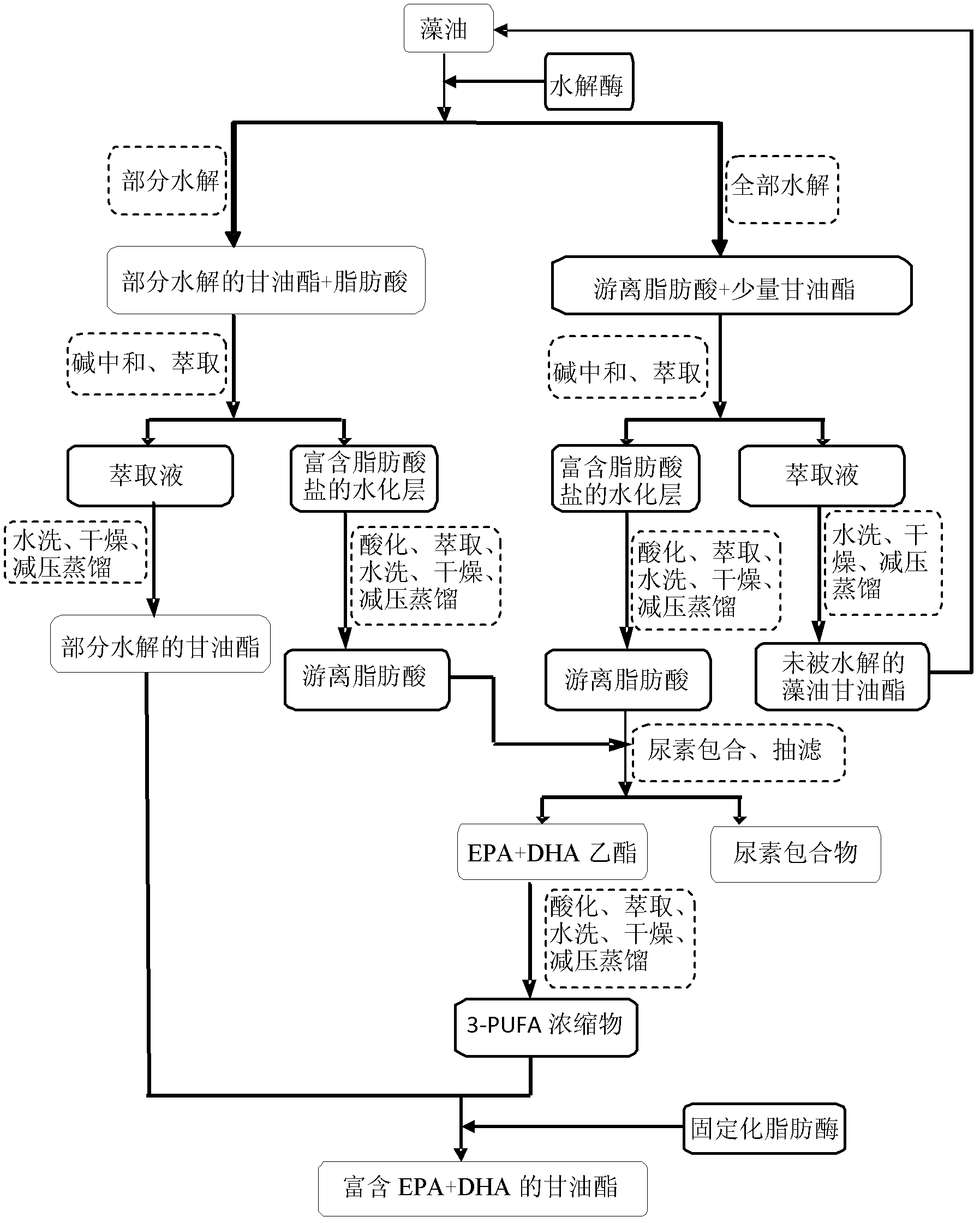Method for preparing glyceride rich in algal oil n-3 polyunsaturated fatty acid through enzyme process
An unsaturated fatty acid, algal oil-rich technology, applied in fermentation, chemical recovery, etc., can solve the problems of long reaction time, unfavorable reaction mass transfer, and high reaction temperature
- Summary
- Abstract
- Description
- Claims
- Application Information
AI Technical Summary
Problems solved by technology
Method used
Image
Examples
example 1
[0062] (1) Enzymatic partial hydrolysis of algae oil
[0063] Weigh 10 g of algae oil sample, add pH 8.0 phosphate buffer according to the mass ratio of algae oil to buffer of 1:0.6, add Candida sp.99-125 lipase enzyme according to the amount of 1500U / g algae oil powder, add cyclodextrin in an amount twice the mass of enzyme powder, fill nitrogen as an inert gas for sealing protection, hydrolyze at 50°C until the hydrolysis rate reaches 60%, stop the reaction, remove enzyme powder by suction filtration, and filtrate Neutralize with KOH, add n-hexane to extract partially hydrolyzed glycerides, and wash the extract with deionized water until neutral, and pass through anhydrous Na 2 SO 4 Drying is carried out, and the solvent is distilled off under reduced pressure to obtain partially hydrolyzed glycerides primarily enriched in n-3 polyunsaturated fatty acids as the main product. The hydration layer was acidified with 2mol / L HCl, and then the free fatty acids were extracted wit...
Embodiment 2
[0071] Embodiment 2 is different from embodiment 1 in that:
[0072] In step (1), the mass ratio of algae oil to buffer is 1:1, lipase enzyme powder is added according to the amount of 600U / g algae oil, and cyclodextrin is added according to the amount of 0.5 times the mass of enzyme powder; Under hydrolysis, after the hydrolysis rate reaches 40%, stop the reaction.
[0073] In step (2), according to the mass ratio of algae oil and buffer solution, add the amount containing 5mMCaCl 2 phosphate buffer solution, add lipase enzyme powder according to the amount of 600U / g algae oil, add cyclodextrin according to the amount of 0.5 times the mass of enzyme powder; carry out hydrolysis reaction at 35 ° C, after the hydrolysis rate reaches 20%, according to The amount of 0.5wt% algae oil is supplemented with Ca(OH) 2 , The total hydrolysis time is 48h.
[0074] In step (3), the ratio of fatty acid: urea: ethanol is 1:2:5 (w / w / v), blending at 60°C for 60 minutes, and inclusion at 4°...
Embodiment 3
[0078] Embodiment 3 is different from embodiment 1 in that:
[0079] In step (1), the mass ratio of algae oil to buffer is 1:0.8, lipase enzyme powder is added according to the amount of 1200U / g algae oil, and cyclodextrin is added according to an amount 1.5 times the mass of the enzyme powder; Under hydrolysis, after the hydrolysis rate reaches 59%, stop the reaction.
[0080] In step (2), according to the mass ratio of algae oil and buffer solution, add the amount containing 8mMCaCl 2 Phosphate buffer solution, add lipase enzyme powder according to the amount of 1200U / g algae oil, add cyclodextrin according to the amount of 1.5 times the mass of enzyme powder; carry out hydrolysis reaction under the condition of 40 ℃.
[0081] In step (3), the ratio of fatty acid: urea: ethanol is 1: 3.5: 9 (w / w / v), and they are blended at 70°C.
[0082] In step (4), the molar ratio of partially hydrolyzed glyceride to n-3 polyunsaturated fatty acid concentrate is 1:8, and immobilized lipa...
PUM
 Login to View More
Login to View More Abstract
Description
Claims
Application Information
 Login to View More
Login to View More - R&D
- Intellectual Property
- Life Sciences
- Materials
- Tech Scout
- Unparalleled Data Quality
- Higher Quality Content
- 60% Fewer Hallucinations
Browse by: Latest US Patents, China's latest patents, Technical Efficacy Thesaurus, Application Domain, Technology Topic, Popular Technical Reports.
© 2025 PatSnap. All rights reserved.Legal|Privacy policy|Modern Slavery Act Transparency Statement|Sitemap|About US| Contact US: help@patsnap.com



